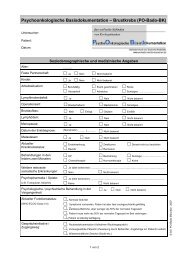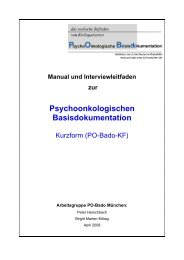PO-Bado Manual (2 - PO-Bado - TUM
PO-Bado Manual (2 - PO-Bado - TUM
PO-Bado Manual (2 - PO-Bado - TUM
You also want an ePaper? Increase the reach of your titles
YUMPU automatically turns print PDFs into web optimized ePapers that Google loves.
<strong>PO</strong>-<strong>Bado</strong> <strong>Manual</strong> (© work group <strong>PO</strong>-<strong>Bado</strong> 2004) 8<br />
physicians, nursing staff, family members). Own initiative would also encompass cases in<br />
which the patient asked the physician about a psychosocial professional on his/her own and<br />
was then referred by this physician to a counselling service. Rater’s Initiative refers to cases in<br />
which the contact came from the examiner without previous identification of a psychosocial<br />
indication, e.g. in the case of a routine admission interview or an introductory meeting with a<br />
psychosocial service.<br />
3.2 Physical, psychological and additional distress<br />
The following three central dimensions of the <strong>PO</strong>-<strong>Bado</strong> deal with stressors which the patient<br />
may suffer from. Physical, psychological, and additional distress are differentiated. These<br />
factors were chosen on the grounds of clinical and psychometric quality criteria (including<br />
validity and reliability).<br />
With these items the patient’s subjective level of disturbance is rated. Hence they do not refer<br />
merely to a description of symptoms, but to the patient’s personal experience.<br />
� The central evaluation criterion is: How strongly does the patient suffer from<br />
each individual aspect or consequence of the illness?<br />
The following example illustrates this: A patient describing a strong loss of appetite but not<br />
suffering from it would be rated as not distressed by this particular aspect, as subjectively the<br />
patient does not subjectively suffer from the loss of appetite. On the other hand, a patient only<br />
slightly restricted in his ability to move but suffering considerably from it would be rated as<br />
distressed by this condition.<br />
The assessment should only take into account the patient’s subjective condition in the last<br />
three days. If a patient reports e.g. having been in pain one week ago but that the pain has<br />
been well treated in the meantime and does not disturb him/her any more, the rating 0 (not<br />
disturbed at all) would apply.<br />
Each factor is to be rated according the following general principle:<br />
0 not at all: There is no evidence that the patient suffers from this aspect or it does<br />
not apply to the patient. 0 should also be marked if no information is<br />
available.<br />
1 a little: The patient suffers slightly from this aspect but not so strongly that the<br />
stressor constitutes a serious distress.<br />
2 moderately: The patient feels strained and restricted by this aspect. There is a<br />
subjective suffering of medium intensity.








